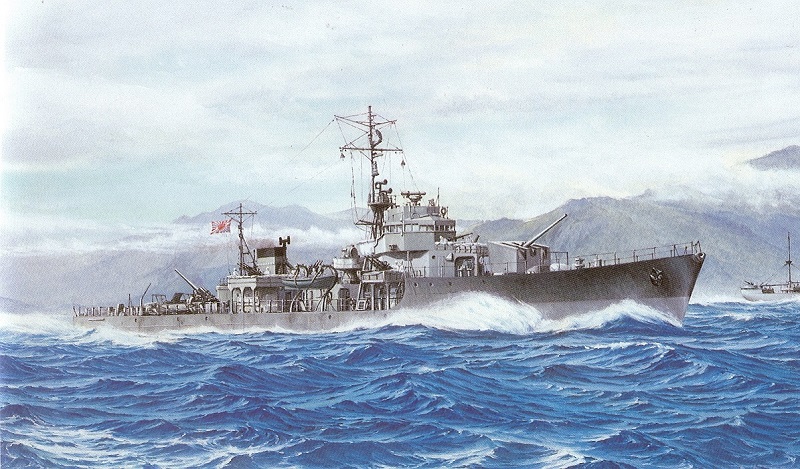© 2006-2015 Bob Hackett, Sander Kingsepp and Peter Cundall
Revision 3
3 January 1944:
Osaka. Laid down at Hitachi’s Sakurajima shipyard as kaibokan No. 329.
10 April 1944:
Launched and named HIBURI .
27 June 1944:
Completed and registered in the IJN. LtCdr Ishikawa Hiroshi (64) is the Commanding Officer. Assigned to Sasebo Naval District.
July 1944:
Works up in Saeki Bay.
22 July 1944:
Departs Saeki for Sasebo.
23 July 1944:
Arrives at Sasebo.
31 July 1944:
Departs Sasebo for Moji.
1 August 1944:
Arrives at Moji, departs at 1600 that same day.
2 August 1944:
Returns to Sasebo.
4 August 1944:
Assigned to the General Escort Command's First Surface Escort division.
5 August 1944:
At 1600 HIBURI departs Sasebo for Takao joining convoy MOTA-22 that departed Moji the previous day. The convoys escorts now include HIBURI and kaibokans ETOROFU, CD-25 and CD-32. MOTA-22 consists of KENJO, GASSAN, HAKUSAN, TEIKA (ex French CAP VARELLA), TERUKUNI, TACHIBANA, NANREI, GENKAI, TEIHOKU (ex French PERSEE), HIOKI, MANSHU, SHIRANESAN, SHONAN, RAKUTO and KOSHIN MARUs and YAMAMIZU MARU No. 2, DAIBOSHI MARU No. 6 and five unidentified ships.
6 August 1944:
Off SW Kyushu. At 0411, LtCdr (later Admiral/CINCPACFLT) Bernard A. Clarey’s (USNA ’34) USS PINTADO (SS-387) torpedoes and sinks SHONAN MARU at 30-53N, 129-45E. Three ship's gunners and two crewmen are KIA.
9 August 1944:
At 1310, KOSHIN MARU's cargo suddenly explodes and the ship sinks at 26-10N, 124-15E. 28 crewmen are KIA.
10 August 1944:
At 1600 arrives at Kirun (Keelung). GASSAN, HAKUSAN, KENJO, TEIKA and HIOKI MARUs are detached.
11 August 1944:
At 0330 departs Keelung
12 August 1944:
At 1430 arrives at Saei (Tsoying) near Takao.
17 August 1944: Operation "SHO-1-GO" (Victory) - The Defense of the Philippines:
At 0600 HIBURI departs Mako with kaibokan SADO (F), ETOROFU and MATSUWA to provide distant anti-submarine cover for convoy HI-71. HIBURI and the other kaibokan do not sail with the convoy, but provide distant cover, hunting for submarines en-route.
HI-71 is comprised of oilers AZUSA, TEIYO, EIYO, ZUIHO and KYOKUTO MARUs, fleet oiler HAYASUI, transports TEIA (ex French ARAMIS), AWA, NOTO, HOKKAI, NOSHIRO MARUs and IJA landing craft depot ships TAMATSU and MAYASAN MARUs and cargo ships KASHII and NISSHO MARUs. The convoy's screen is provided by Rear Admiral (Vice Admiral, posthumously) Kajioka Sadamichi (39) (former CO of KISO) of 6th Escort Convoy with destroyers FUJINAMI and YUNAGI, old destroyer ASAKAZE, kaibokan HIRADO, KURAHASHI, MIKURA, SHONAN and CD-11 and escort carrier TAIYO. At 0800, in typhoon weather, HI-71 sorties from Mako for Manila.
18 August 1944:
At 0524, LtCdr (later Rear Admiral-Ret) Louis D. McGregor's (USNA ’30) USS REDFISH (SS-395) torpedoes and damages EIYO MARU. Destroyers ASAKAZE and YUNAGI are detached to escort her back to Takao.
Off Cape Bolinao, Luzon. At 2210, LtCdr (later Captain) Henry G. Munson's (USNA ’32) USS RASHER (SS-269) torpedoes and sinks oiler TEIYO MARU in a surface radar attack. 41 crewmen and 58 passengers are KIA. At 2222, Munson torpedoes and sinks carrier TAIYO at the rear of the convoy. Because of the fire and speed of sinking, most of her crew are lost and about 790 passengers perish; but by some miracle, Captain Sugino Shuichi (46) is among the just over 400 surviving crew and passengers. At 2310, RASHER, still on the surface, hits transport TEIA MARU (ex French ARAMIS) with three torpedoes using radar bearings. The ex-French liner is set afire and sinks. TEIA MARU was carrying 4,795 Army and 427 civilians. 2,316 troops, 275 passengers, six guards, four gunners, 10 special lookouts, and 54 crewmen are KIA.
19 August 1944:
The convoy splits into two groups. Just past midnight, USS RASHER, still running on the surface, closes on an eastbound group of three large ships and one escort. At 0033, LtCdr Munson puts two radar-directed torpedoes into the port sides of AWA and NOSHIRO MARUs. Both ships beach themselves near Port Currimao. LtCdr (later Cdr) Charles M. Henderson's (USNA ’34) USS BLUEFISH (SS-222) and LtCdr (later Captain) Gordon W. Underwood's (USNA ’32) USS SPADEFISH (SS-411) join in the attack on HI-71. At 0320, USS BLUEFISH hits and sinks HAYASUI. Captain Sugiura Keizaburo (49) is KIA. He is promoted Rear Admiral, posthumously. The number of survivors is unknown. USS SPADEFISH hits TAMATSU MARU with two torpedoes and the big IJA landing craft depot ship rolls over and takes down 4,755 troops and 135 crewmen. HI-71 makes for San Fernando.
20 August 1944:
SADO (F), ETOROFU, HIBURI and MATSUWA arrive at the area of the attacks and commence a search for submarines.
21 August 1944:
Rear Admiral Kajioka orders HIBURI, SADO and MATSUWA to proceed to Manila.
22 August 1944:
Hidai Bay, 25 nms W of Manila Bay. At 0456, Cdr (MOH, posthumously) Samuel D. Dealey’s (USNA ’30) USS HARDER (SS-257) torpedoes both HIBURI and MATSUWA in their port sides and stops them dead in the water. MATSUWA loses her bow.
At 0524, SADO is torpedoed by LtCdr (Rear Admiral-Ret) Chester W. Nimitz Jr’s (USNA ’36) USS HADDO (SS-255). At 0649, MATSUWA is sunk by USS HARDER. 134 sailors are KIA and 12 wounded. At 0720, USS HADDO fires three torpedoes at the two remaining derelicts. One misses, but the others hit SADO squarely and sink her. 73 sailors are KIA.
At 0755, HIBURI sinks bow first at 14-15N, 120-25E. 154 hands are killed and wounded. Lt Ishikawa is promoted LtCdr posthumously.
10 October 1944:
Removed from the Navy List.
Authors' Note:
Thanks for assistance go to Dr. Higuchi Tatsuhiro of Japan and to Gilbert Casse of France. Thanks also go to Jeff Donahoo of Iowa and Matthew Jones of Ohio for help in identifying kaibokan COs.
-Bob Hackett, Sander Kingsepp and Peter Cundall.
Back to
Escort Page



